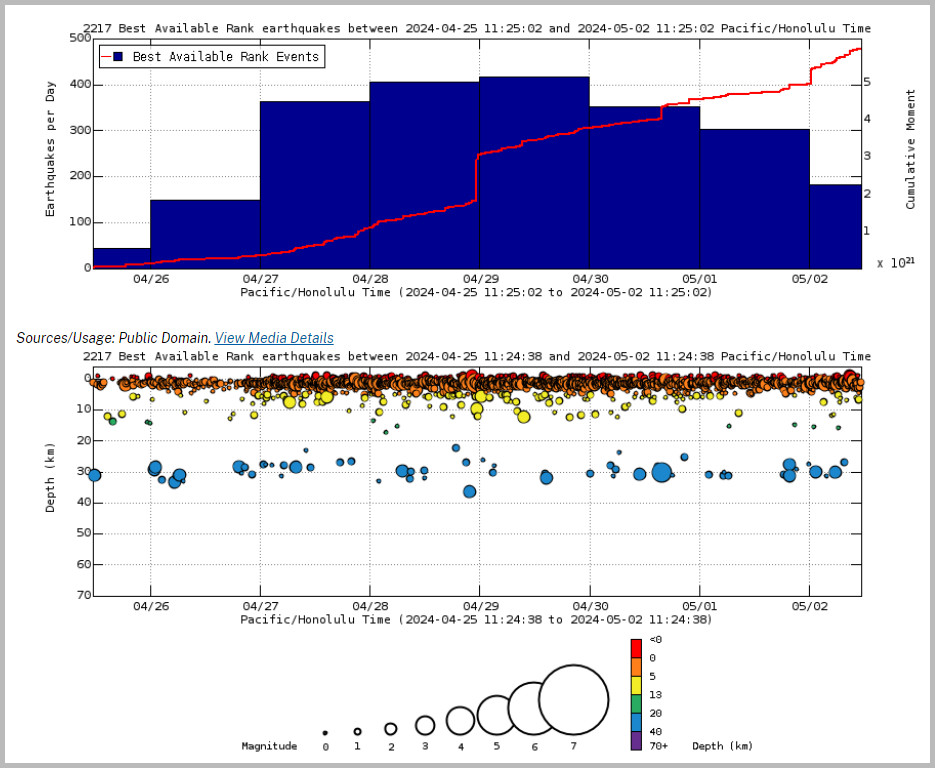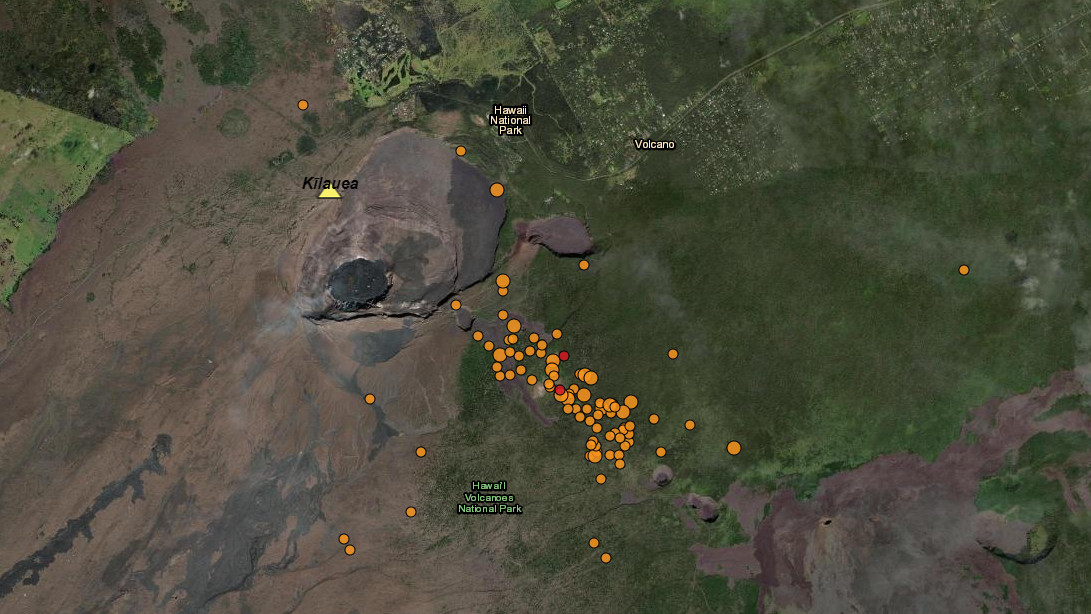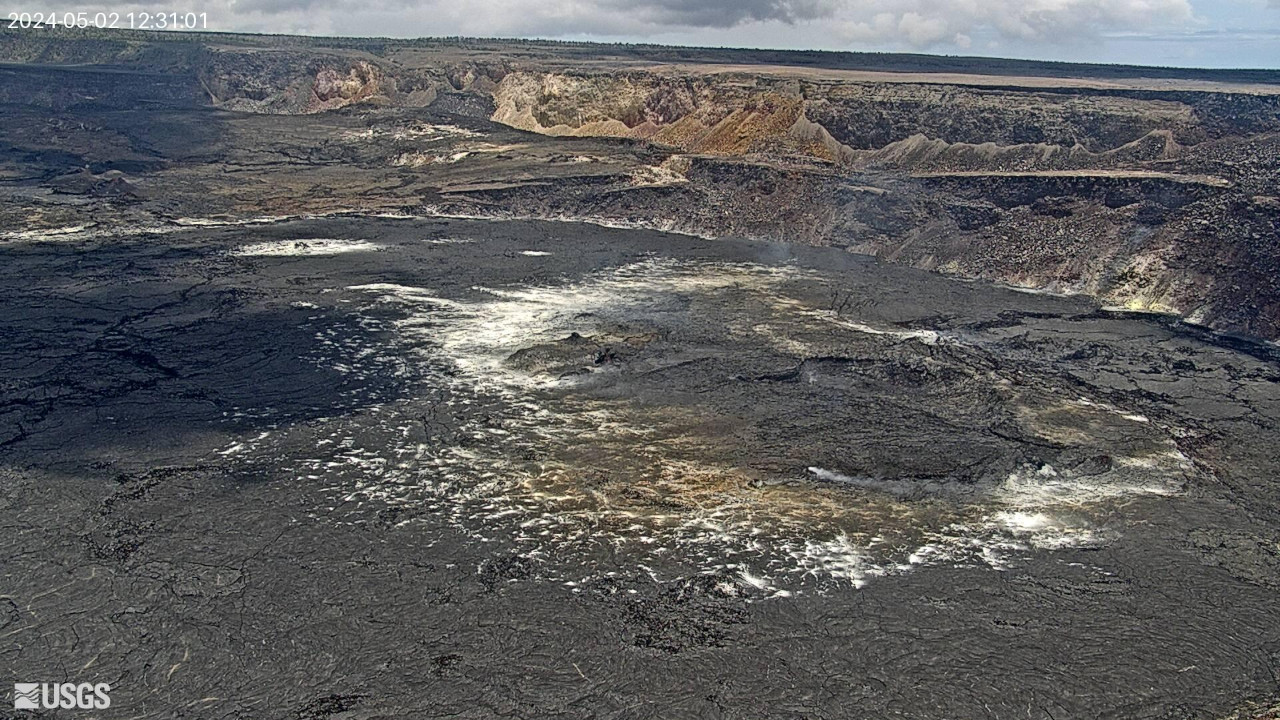(BIVN) – Kīlauea volcano is not erupting, and current USGS Volcano Alert Level is at ADVISORY.
The heightened state of unrest that began on April 27 continued Thursday, with elevated seismicity ongoing beneath the upper East Rift Zone and the caldera south of Halemaʻumaʻu.
Scientists say both inflation and earthquake counts increased overnight, but remain below the peak values recorded several days ago. There have been over 1,500 earthquakes beneath the upper East Rift Zone since Saturday.
“The current intensity of seismic swarms suggests that formation of a dike beneath the upper East Rift Zone or Kīlauea caldera is a potential outcome,” the USGS Hawaiian Volcano Observatory wrote on Thursday morning. “However, if a dike is emplaced beneath the upper East Rift Zone, there is a much higher historical probability of it resulting in an intrusion (where magma remains below the surface) than as an eruption (where the dike breaks the surface).”
From the USGS HVO on Thursday, May 2nd:
Summit and upper East Rift Zone Observations: An increase in earthquake activity began just after midnight on April 27 beneath the upper East Rift Zone and beneath Kīlauea caldera south of Halemaʻumaʻu. Over the past few days, earthquake locations have been focused primarily between the southeast side of Kīlauea caldera beneath Keanakākoʻi crater and the intersection with Hilina Pali Road. The number of earthquakes is similar to yesterday with approximately 270 earthquakes in this area over the past 24 hours. However, since midnight hourly earthquake activity has increased from 10-12 earthquakes per hour to 12-15 earthquakes per hour with most of the activity southeast of Puhimau crater. Depths remain concentrated between 2-3 km (1.2-1.9 miles) beneath the surface with scattered shallower earthquakes. There have been few earthquakes in the caldera south of Halemaʻumaʻu over this same period. Earthquake magnitudes in both areas have not exceeded M3.0 in the past 24 hours, with the vast majority below M2.0. Since the start of the unrest, there have been over 1500 earthquakes beneath the upper East Rift Zone and approximately 225 earthquakes beneath the southern end of Kīlauea caldera.

From USGS: Earthquake Rates and Depths shortly after noon on Thursday. Above Top: Number of earthquakes per day during the past week (blue bars). The red line is the cumulative moment (energy) release. Bottom: Depth of earthquakes during the past week in the area shown on the map above. Depth is reported relative to sea level, which is equal to a depth of zero on the above plot. On both figures, circle-size represents magnitude, and color indicates depth.
Ground deformation continues with ongoing uplift at the summit and south of the caldera into the Southwest Rift Zone. Around 1:00 PM yesterday, the tilt signal at Uēkahuna turned over to inflation as part of a deflation-inflation (DI) event that began on 29 April at 6:00 PM. Inflation slowed at around 9 PM and continues at this rate this morning. The Sand Hill tiltmeter continues to record steady inflation of the south end of the caldera and increased slightly around 9 PM to rates observed this morning.
Sulfur dioxide (SO2) gas emission rates remain low. An SO2 emission rate of approximately 52 tonnes per day was recorded on April 23.
Rift Zone Observations: All seismic activity on the East Rift Zone is confined to the upper East Rift Zone, with no significant earthquakes occurring past the Mauna Ulu region. At this time, there are still no signs of deformation beneath the upper East Rift Zone beyond Keanakākoʻi crater. Seismicity in Kīlauea’s Southwest Rift Zone remains low overall. Measurements from continuous gas monitoring stations downwind of Puʻuʻōʻō in the middle East Rift Zone—the site of 1983–2018 eruptive activity—continue to be below detection limits for SO2, indicating that SO2 emissions Puʻuʻōʻō are negligible.
Analysis: At this time, it is not possible to say with certainty if this increase in activity will lead to an intrusion or eruption in the near future – or simply continue as seismic unrest at depth. The upper East Rift Zone is currently being pressurized by inflation of the main magma reservoir beneath the southern end of Kīlauea caldera and south of Keanakākoʻi crater within Hawai‘i Volcanoes National Park. The upper East Rift Zone is reacting to this pressurization. While both inflation and earthquake counts increased overnight, they remain below the peak values recorded several days ago. The current intensity of seismic swarms suggests that formation of a dike beneath the upper East Rift Zone or Kīlauea caldera is a potential outcome. However, if a dike is emplaced beneath the upper East Rift Zone, there is a much higher historical probability of it resulting in an intrusion (where magma remains below the surface) than as an eruption (where the dike breaks the surface). In either case, dike emplacement from these shallow depths can take place with very little warning. Both intrusions and eruptions can cause significant surface cracking that can render roadways in the area impassable.
The temporary closures within Hawaiʻi Volcanoes National Park due to the elevated activity include:
- Chain of Craters Road from the intersection at Crater Rim Drive will close at 5 p.m. Monday, April 29.
- Hilina Pali Road is closed to all use. Kulanaokuaiki Campground is closed.
- Overnight camping is suspended for all coastal sites, Nāpau and Pepeiao Cabin.
- Kaʻū Desert Trail is closed from the Footprints Exhibit.
- Maunaiki Trail is closed.



by Big Island Video News1:08 pm
on at
STORY SUMMARY
HAWAIʻI VOLCANOES NATIONAL PARK - Elevated seismicity continues beneath Kīlauea, in the upper East Rift Zone and caldera south of Halemaʻumaʻu.